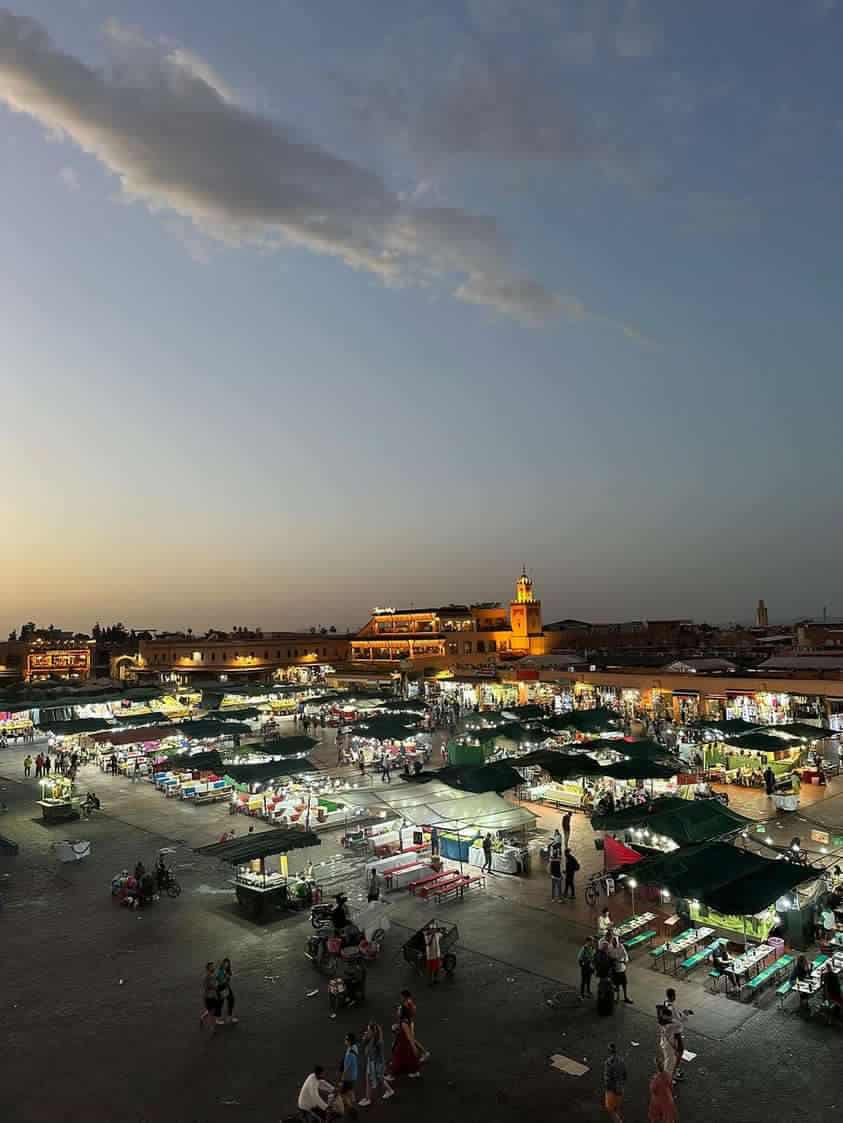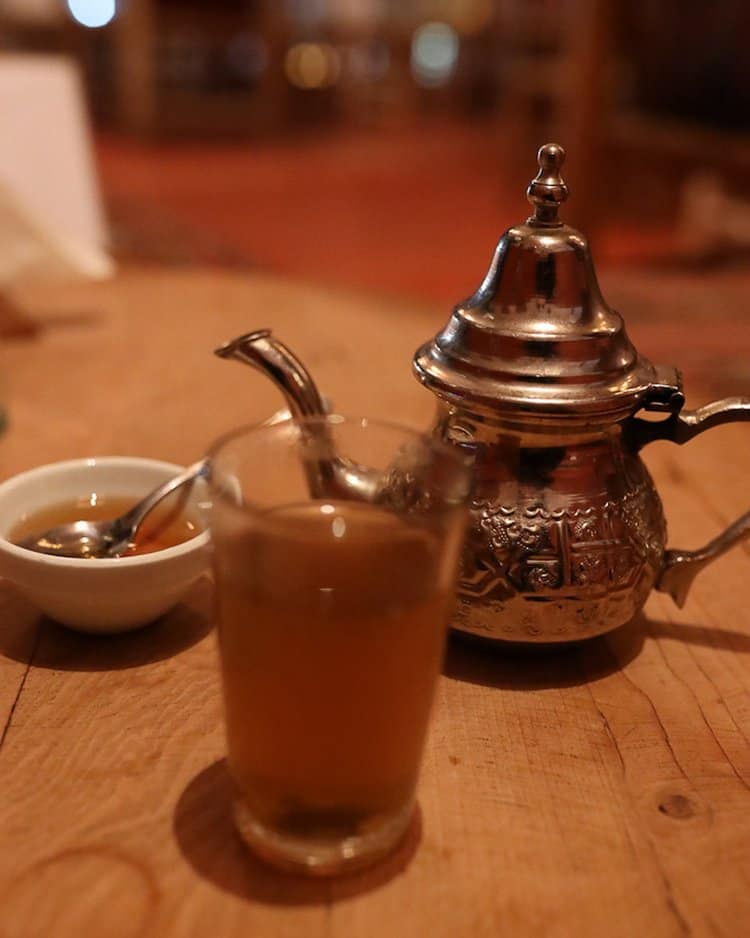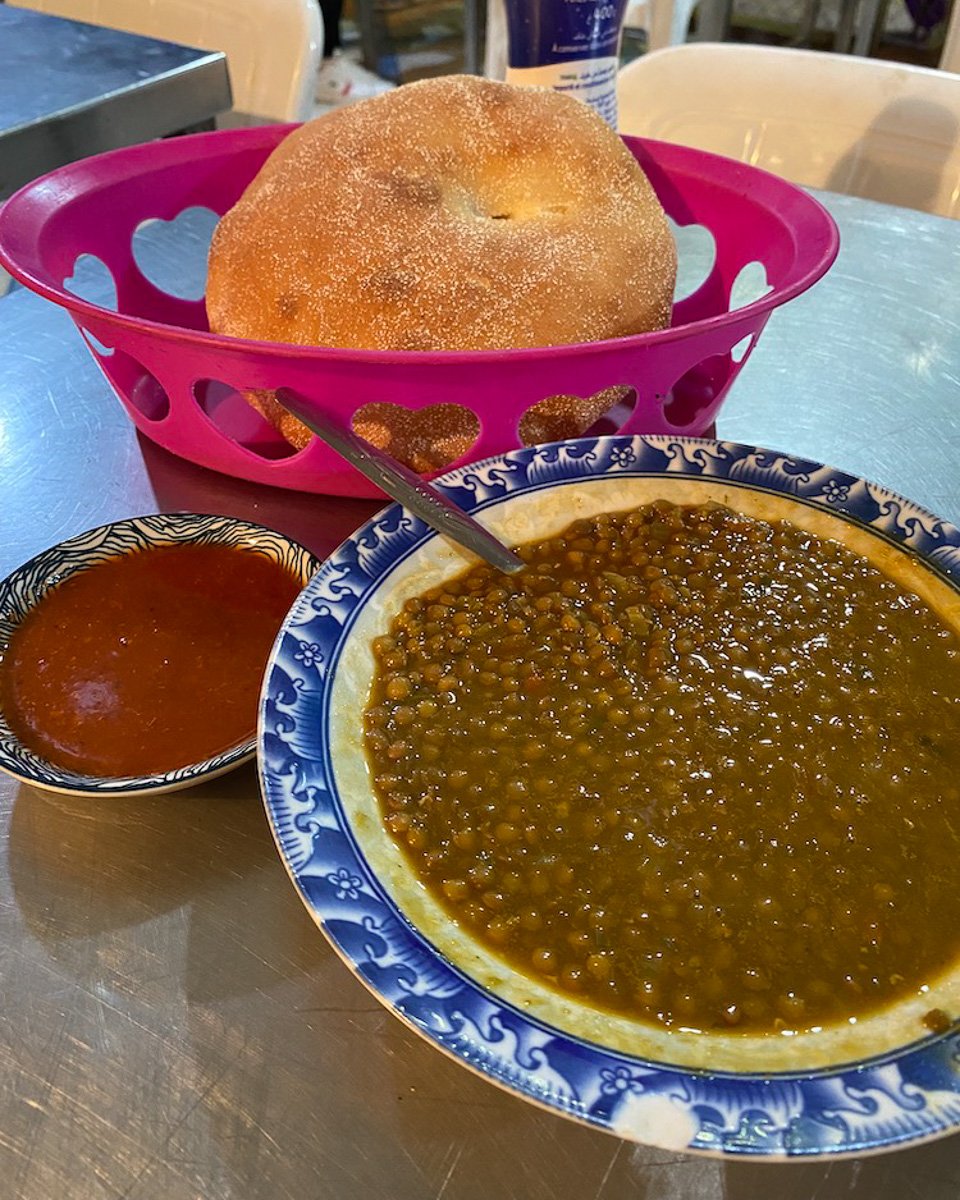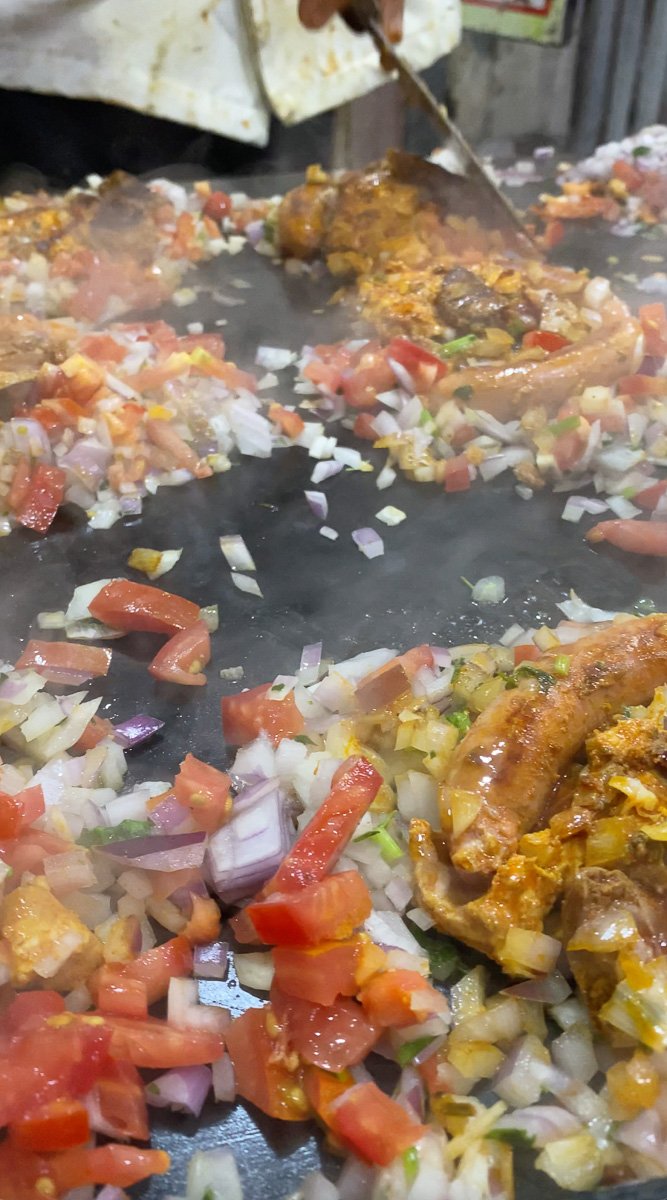Don’t Leave Marrakech Without Trying These 12 Amazing Street Foods

Moroccan food is my favorite cuisine in the world, and I’m super excited to share this list of all of the best street foods in Marrakech. Keep reading this guide for everything you need to know about the phenomenal street food in Morocco & Marrakech; its history, where to get it, and how much it usually costs!
FYI: Some links on my site are affiliate links that help support my site at no additional cost to you. Read more on my privacy policy page.

Take A Street Food Tour!
✔️ Learn More About Moroccan Culture
✔️ Avoid Getting Harassed & Scammed!
✔️ English-Speaking Guide

12 Best Moroccan Street Foods to Try in Marrakech
1. Moroccan Snails (also called Babbouche or Ghlal)
Strolling through Jemaa el Fna square at night you’ll see a row of stalls piled high with steaming snails still in the shell. To this day I have no idea where they come from! There are always so many snail vendors every night and I’ve never seen a single snail in Morocco (I guess they all go straight to the pot?). Honestly, I can’t say I appreciate the taste of this snack but for the more adventurous eater, it’s an experience that should be missed. Moroccan Escargot (Babbouche) is very different from the French counterpart: instead of butter, the snails are cooked in spices, and instead of fancy restaurants, Babbouche is quintessential Moroccan street food.
👉 Where to Get: Jemaa el Fna square after 5 PM always has Babbouche/Ghlal brewing!
Fun Fact: Babbouche is considered a folk medicine in Morocco – It’s said to be able to cure anything from the common cold to fertility issues!
2. Tagine (Kofta, Lamb, Chicken, Berber)
Tagine (also spelled Tajine) is synonymous with Morocco – it’s named after the cone-shaped pot in which the food is cooked, and then also served. Tagine is delicious and popular with tourists because the dish it’s served in is a beautiful presentation. There’s a certain way you’re supposed to eat Tagine; you need to take a small piece of Moroccan bread in your right hand (never left!) and scoop up the contents. Traditionally, people don’t use forks and knives for this dish. Tagines are also typically eaten communally, with everyone scooping from one big pot.
👉 Where to Get: You’ll find Tajines served everywhere in Morocco, from 5-star restaurants to street food stalls.
💰 Budget Eats: A fancy tagine can cost $20, but the tagines you get on the street where the locals go usually cost more like $2-3.

Most Common Types of Tagines
✔️ Kefta Tagine: Resembling Shakshuka, this tagine has a tomato sauce base with little meatballs, and then eggs are poached in the sauce.
✔️ Tagine du Poulet: Chicken tagine is often served with preserved lemon (a Moroccan classic) and green olives.
✔️ Tagine D’Agneau: My favorite! This slow-roasted lamb tajine is often served with fruits, like prunes or apricots, and a sprinkle of almonds.
✔️ Tagine du Berber: Named after the Berber (also called Imazighen) people that are indigenous to Morocco, this tagine is lighter on meat and heavier on vegetables. Berber tagines usually have potatoes, zucchini, carrots, and peas + a protein.


3. Mechoui (from Mechoui Alley in Marrakech)
Mechoui Alley is a little area off of Jemaa El Fna square where there are a handful of shops devoted to the dish. Mechoui is a whole slow-roasted lamb that’s sold by weight and eaten with Moroccan bread. The shops in Mechoui Alley have been cooking lamb for generations, but you won’t see any meat roasting in their kitchens. This is because the lamb is all roasted underground, with the only access point being a hatch in the floor.
👉 Where to Get: The most famous restaurant in Mechoui Alley is Chez Lamine.
Fun Fact: Chez Lamine is owned by a man whose father would make Mechoui for the late King Hassan II. In Mechoui Alley you can buy Mechoui by the KG, which is usually a leg of lamb still on the bone, Tangia, or a whole sheep’s head!
Type of Mechoui: Tangia
When I first came to Marrakech everyone kept telling me to try Tangia – I kept saying I had, thinking they were saying Tagine 🤦♀️. Tanjia is a totally different thing; it’s just lamb, cubed, and incredibly slow-roasted with a bit of cumin and salt. You buy it by weight, at Chez Lamine 1/2 KG of Lamb is 75 Moroccan DH ($8) and 1 KG is 150 DH ($16).

Type of Mechoui: Whole Roasted Sheep’s Head (Also Called “Ras”)
I was dining with a vegan friend in Mechoui Alley so I didn’t partake in this treat and stuck to the Tangia, but whole roasted sheepshead is a Moroccan specialty that you can get in Jemaa el Fna square proper but locals know to go off to Mechoui Alley for the real deal.
Tip: Apparently the eyeball is considered the tastiest part of this dish, so if you’re not squeamish and looking for a culinary adventure give it a try!

4. Pigeon Pastilla (also called B’stilla)
Moroccan Pigeon Pastilla (yes! It actually has pigeon in it) is sweet, spicy, and savory. The pigeon filling is spiced with cardamom, cumin, cinnamon, ginger, and saffron – while the dough is really similar to a flaky filo dough you would find in something like baklava. To further add to the sweet/savory combo, B’stilla is usually served sprinkled with powdered sugar! It’s delicious.
Where to Get: I would recommend getting these from a higher-end cafe since B’stilla is more of a special occasion food, but they do also sell it on street carts!

5. M’semen: Moroccan Crepe (But it’s Better Than a Crepe) With Savory & Sweet Filling
M’semen (or Msemmen) is a Moroccan pastry that’s like a combination of a French Crepe and an Indian Paratha. It’s AMAZING. You can get M’semen stuffed with savory or sweet fillings, my favorite filling is with honey. You can get lots of different fillings and one M’Semen only costs 5-10 DH (less than $1).
Tip: Always make sure you’re getting fresh M’semen that’s being fried right in front of you! It’s 1000x better that way.

6. NossNoss Coffee: Moroccan Cappucino
NossNoss literally means “half-half”, as in half milk and half coffee. It’s the Moroccan take on a latte or cappuccino, and lovely to order because it comes out with clear layers of milk and coffee. Morocco doesn’t have a huge coffee culture, the preferred beverage is usually tea. You’ll likely be able to find an Americano at any tourist cafe, but at the local spots, there usually is only Cafe Noir (espresso) and NossNoss.
Tip! While I believe Morocco is safe for women travelers, there are some cultural differences to remember. For example, if you see only men in a coffee shop, that might be a “male-only” cafe.

7. Moroccan Mint Tea: Served Everywhere & With Every Meal
I’m putting this on the list of things you should try in Marrakech, but it would be almost impossible to leave Marrakech without trying Mint Tea. Mint tea is served with every meal, and offered on every occasion – it’s almost more common than water!
There is a whole ritual around tea in Morocco; first, you steep the tea of black tea leaves with dried mint, then a large cube of sugar is added to the pot. To incorporate the sugar and the tea together, the tea is then poured from up high (seriously, the higher the better), and then the process is repeated 3 or more times by pouring the cup of tea back into the teapot. Pouring it from up high makes the sugar in the tea frothy, which is a desirable quality – the frothiness is also supposed to make the tea less bitter, but the tea already usually has a ton of sugar to do that.
Tip! I’m always trying to be healthy while traveling so I asked for my tea without sugar, big mistake! Mint tea is incredibly bitter – it definitely needs a sweetener.
8. Grey Wine – “Vino Gris” – Moroccan Local Wine
Not exactly a “street food”, but I wanted to include Vino Gris on this list because it’s uniquely Moroccan. Alcohol is forbidden in the Muslim religion, so it isn’t super common in Morocco, but they do still have wineries and vineyards. Grey Wine is actually a type of Rosé; it’s made from red grapes in the style of white wine.
👉 Where to Get: My favorite place for a relaxed glass of Vin Gris (Grey Wine) in Marrakech was Cafe Árabe in the Old Medina. You sit on big pillows on the floor with low tables and it’s very romantic, they also have hookah.
Fun Fact: I’m not sure how true this is, but someone told me on my first trip to Morocco that the rule in Marrakech is no alcohol could be consumed in view of the Koutoubia Mosque. To get around this rule, people just started building bars without windows 😂.

9. Bissara Soup & Moroccan Lentil Soup: Staples of Street Food Eaten at Breakfast With Crusty Bread
Lumping these two together because you should have at least one before leaving Morocco!
Bissara Soup
Sometimes written as Soupe de fève, Bissara soup is made from the puree of dried fava beans, and always served with a side of wonderful crusty Moroccan bread. I had an elevated version of this dish when I was in Casablanca at La Sqala Cafe, but Bissara is typically simple food – eaten usually at breakfast, you’ll find shops & stalls serving Bissara by the ladle-full along the streets of the souks.

Lentil Soup
Moroccan lentil soup is probably one of the most popular culinary exports from the region. I know I’ve definitely had it at some trendy vegetarian cafes in NYC at some point or another. Similar to an Indian Dal, Moroccan lentil soup is popular for a good reason; it’s tasty, spicy, filling, and incredibly cheap. When I was staying in the gorgeous beachside village of Taghazout my typical meal would be a Moroccan lentil soup and a mint tea, totaling less than $1.

10. Fresh Pomegranate Juice
You’ll see mixed juice vendors in Jemaa El Fna Square in Marrakech, but the locals don’t go there! The locals frequent orange and pomegranate juice vendors in the streets of the Medina. The juices are made right in front of you, and you can see they’re not watered down at all – I had never had fresh-pressed pomegranate juice before coming to Morocco, it’s lovely. There are no set locations for the juice vendors, you’ll see them out in the daytime rolling their carts through the souks. I’ve had luck finding the juice vendors in Place Des Epices square in Marrakech front of my favorite cafe, Cafe des Epices.
Tip! I didn’t have a problem getting sick in Morocco, but I have read that it’s important to make sure juice is pressed fresh in front of you so you know it’s not thinned out with tap water.

10. Couscous (But Only on Fridays)
Couscous is the national dish of Morocco. It’s typically served only on Fridays, which is the Muslim holy day, and eaten from a large platter communally. At tourist restaurants, you can find couscous served any day of the week; but for some local spots – you won’t find anything on the menu but couscous on Fridays!
What is Couscous?
Couscous is a dish of steam-cooked meat and veg, much like a Tagine, but with a base of teeny tiny balls of semolina (similar to past). Instead of a Tagine, the special pot couscous is cooked in is called a Couscousiere. The proper way to eat couscous is with your hands, but instead of using bread as a scooper you take the couscous itself in your hand and roll the pliable little balls of semolina into a bite-sized piece.

11. Moroccan Pastries (also called Sweetmeats)
Strolling the souks in the old medina you won’t be able to miss sweetmeat stalls; piled high with every confection imaginable, they are truly a sweet tooth’s dream. Moroccan pastries/cookies/sweetmeats have a lot in common with other Arabic desserts, as well as Indian. I actually had my first Jalebi in Morocco, but they’re called Zalabia in North Africa! Common ingredients in Moroccan Sweetmeats are pistachios, walnuts peanuts, almonds, dates, figs, rosewater, and (of course) sugar.
Tip! I see a lot of tourists get overcharged for these, they should be between 2-5 DH per piece (.25 – .5 USD).

12. Sandwich Mixte – Spicy Sandwich Full of Many Different Types of Meat
I swear this is the best sandwich you’ll ever have for $1! A Sandwich Mixte (also called Petit or Grand Mixte) is a combo of ground meat, sausage, turkey, and liver – and then you can pick to have it topped with an egg or a slice of cheese. It sounds like a lot but once they add spices and salsa it’s 👌.
Tip: The street food stall Chez Hicham near Jemaa el Fna in Marrakech sells Sandwich Mixte for 10 DH ($1). Perfect for backpackers!




